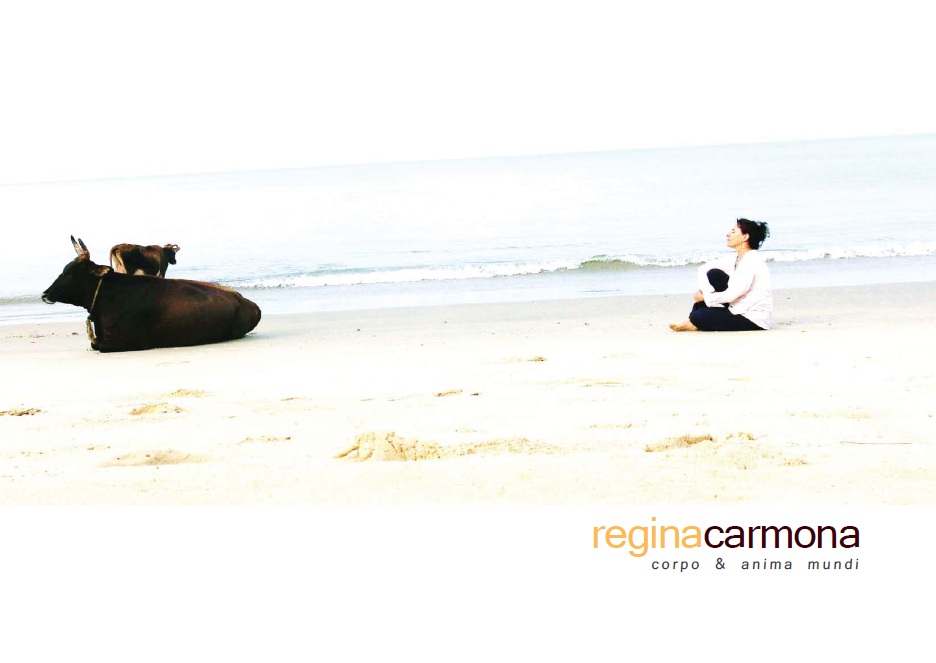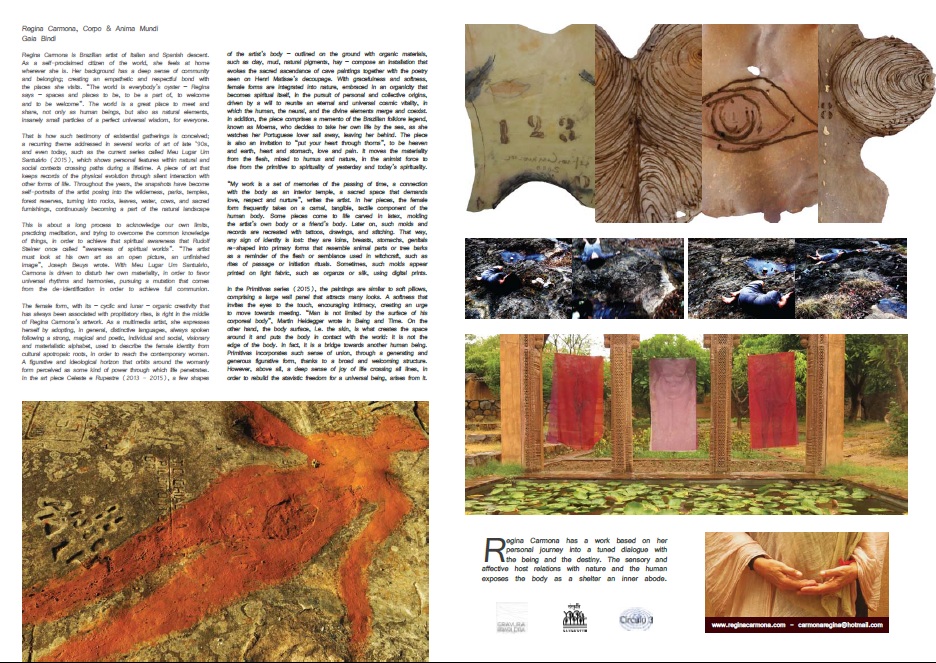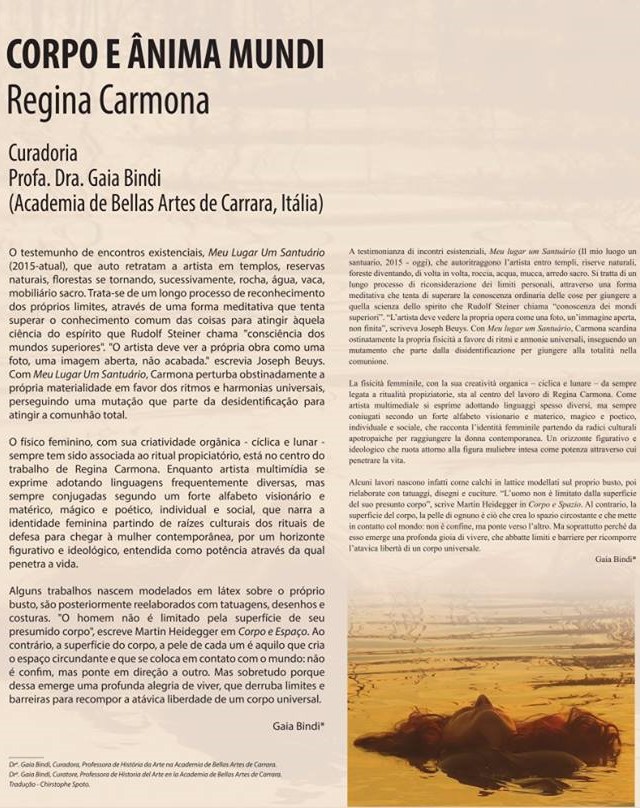De 4/8/2015 a 12/9/2015
Regina Carmona, Corpo & Anima Mundi
Gaia Bindi, curator and Adriana Rede, producer


Regina Carmona is Brazilian artist of Italian and Spanish descent. As a self-proclaimed citizen of the world, she feels at home wherever she is. Her background has a deep sense of community and belonging; creating an empathetic and respectful bond with the places she visits. "The world is everybody’s oyster – Regina says – spaces and places to be, to be a part of, to welcome and to be welcome”. The world is a great place to meet and share, not only as human beings, but also as natural elements, insanely small particles of a perfect universal wisdom, for everyone.
That is how such testimony of existential gatherings is conceived; a recurring theme addressed in several works of art of late ‘90s, and even today, such as the current series called Meu Lugar Um Santuário (2015), which shows personal features within natural and social contexts crossing paths during a lifetime. A piece of art that keeps records of the physical evolution through silent interaction with other forms of life. Throughout the years, the snapshots have become self-portraits of the artist posing into the wilderness, parks, temples, forest reserves, turning into rocks, leaves, water, cows, and sacred furnishings, continuously becoming a part of the natural landscape
This is about a long process to acknowledge our own limits, practicing meditation, and trying to overcome the common knowledge of things, in order to achieve that spiritual awareness that Rudolf Steiner once called "awareness of spiritual worlds". "The artist must look at his own art as an open picture, an unfinished image", Joseph Beuys wrote. With Meu Lugar Um Santuário, Carmona is driven to disturb her own materiality, in order to favor universal rhythms and harmonies, pursuing a mutation that comes from the de-identification in order to achieve full communion.
The female form, with its – cyclic and lunar – organic creativity that has always been associated with propitiatory rites, is right in the middle of Regina Carmona’s artwork. As a multimedia artist, she expresses herself by adopting, in general, distinctive languages, always spoken following a strong, magical and poetic, individual and social, visionary and materialistic alphabet, used to describe the female identity from cultural apotropaic roots, in order to reach the contemporary woman.
A figurative and ideological horizon that orbits around the womanly form perceived as some kind of power through which life penetrates. In the art piece Celeste e Rupestre (2013 - 2015), a few shapes of the artist’s body – outlined on the ground with organic materials, such as clay, mud, natural pigments, hay – compose an installation that evokes the sacred ascendance of cave paintings together with the poetry seen on Henri Matisse’s decoupage. With gracefulness and softness, female forms are integrated into nature, embraced in an organicity that becomes spiritual itself, in the pursuit of personal and collective origins, driven by a will to reunite an eternal and universal cosmic vitality, in which the human, the neural, and the divine elements merge and coexist.
In addition, the piece comprises a memento of the Brazilian folklore legend, known as Moema, who decides to take her own life by the sea, as she watches her Portuguese lover sail away, leaving her behind. The piece is also an invitation to “put your heart through thorns”, to be heaven and earth, heart and stomach, love and pain. It moves the materiality from the flesh, mixed to humus and nature, in the animist force to rise from the primitive to spirituality of yesterday and today’s spirituality.
"My work is a set of memories of the passing of time, a connection with the body as an interior temple, a sacred space that demands love, respect and nurture", writes the artist. In her pieces, the female form frequently takes on a carnal, tangible, tactile component of the human body. Some pieces come to life carved in latex, molding the artist’s own body or a friend’s body. Later on, such molds and records are recreated with tattoos, drawings, and stitching. That way, any sign of identity is lost: they are loins, breasts, stomachs, genitals re-shaped into primary forms that resemble animal parts or tree barks as a reminder of the flesh or semblance used in witchcraft, such as rites of passage or initiation rituals. Sometimes, such molds appear printed on light fabric, such as organza or silk, using digital prints.
In the Primitivo series (2015), the paintings are similar to soft pillows, comprising a large wall panel that attracts many looks. A softness that invites the eyes to the touch, encouraging intimacy, creating an urge to move towards meeting. "Man is not limited by the surface of his corporeal body", Martin Heidegger wrote in Being and Time. On the other hand, the body surface, i.e. the skin, is what creates the space around it and puts the body in contact with the world: it is not the edge of the body. In fact, it is a bridge towards another human being.
Primitivo incorporates such sense of union, through a generating and generous figurative form, thanks to a broad and welcoming structure. However, above all, a deep sense of joy of life crossing all lines, in order to rebuild the atavistic freedom for a universal being, arises from it.
___________________________________________________________________________________________
The small box-set shows images and objects of affection, resulting from the artist’s research, a never-ending look, a day-to-day delight, focused on her craft.
The series A Casa da Mantide Religiosa, in light and wavy fabric canvases, take us back to a sensitive and sensorial art that references beauty, the human being and their nature; to hide elements that, in a way, are connected and relate to sexuality, identity and spirituality.
The piece has been molded upon the artist’s body; several molds were identified with drawings, tattoos and incisions from a specific area where the skin has been injured/wounded during the molding process. These drawings engraved into fabrics refer to stories randomly shared with several women. Stories of pain and happiness so different that end up imprinted on the body, with the light. (RC)
“... The wound is the place where the light enters you”. Rumi.


Rua Ásia, 219, Cerqueira César, São Paulo, SP - CEP 05413-030 - Tel. 55 11 3624.0301
Weekdays: 12 am to 6 pm